Introduction
The Xero Shoes Terraflex should interest both trail runners and ultralight hikers looking for a true minimalist shoe option for rugged terrain.
A super-flexible sole and “zero drop” between heel and toe will satisfy those looking for a natural, quasi-barefoot experience where the foot is free to move and flex and form is not compromised by excessive structure or support. The sole contains just enough cushion to shield the foot from rocks, while offering very good traction. It’s a great choice when rocky terrain or long distances would make barefoot or more extreme minimalist options too slow or painful, or otherwise impractical.
As a caveat to those who have been wearing conventional footwear with elevated heels and other forms of support, you may discover, like me, that you love the more natural experience of minimalist footwear, but make sure to transition slowly so that you don’t overwhelm muscles and tendons that aren’t used to the experience.
Features and Specifications
- Men’s size 9 advertised at 9.6 ounces (my size 12 without the insoles weighed in at ~9 ounces according to our kitchen scale)
- Includes 2 mm removable insoles
- Contains 3 mm of foam cushion (mid-sole)
- 4 mm (height) lugs on the sole
- Sole are backed by a 5,000-mile warranty
- Zero drop, meaning there’s no elevated heel
- Wide toebox
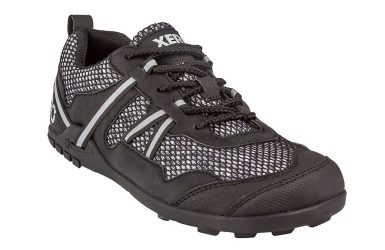
Review Context
For ultralight backcountry travel, the hiker, trail runner, or fast-packer might want to consider the following performance criteria:
- Lowest possible weight, to prevent fatigue
- Good traction on slippery surfaces, like wet rocks, loose dirt, dry leaves, or mud
- Protection from rocks and other sharp objects
- Dries quickly so you don’t walk around with wet feet all day
- Flexible sole and wide toebox, allowing the foot to work naturally
Description of Field Testing
When the Terraflex shoes arrived, I started out by wearing them around town, just to see what they felt like on sidewalks and in the house. I took them out for a run on a path which is a mix of dirt, clay, and grit, and tested them with some short hikes on- and off-trail in order to evaluate traction and comfort on steep slopes, sticky mud, rocky paths, and forest floors covered in dry leaves and abundant deadfall.
Given the heavy snowfall we’ve experienced this winter, I ended up wearing them on several hikes with snowshoes, including an overnighter with a heavy pack. Given conditions and timing, I haven’t had a chance to wear them on a long trail run, but have made some judgments from my experience wearing similar minimalist shoes during ultra-distance trail races and multi-day FKT attempts, such as thru-running New York’s 350-mile Long Path.

Performance Assessment
My assessment of the Terraflex covered the following criteria:
- Comfort
- Protection
- Natural fit
- Traction
Comfort
I found these shoes very comfortable. The materials on the inside of the shoe feel soft, and my feet were fine without socks.
As someone who who rarely wears boots, even in the winter, I found the Terraflex kept my feet warm during the overnight snowshoe hike, where conditions were moderately cold (mid-20 F’s) with 2+ feet of snow. Snow shoes and hiking crampons both strap on securely to the shoes, without discomfort. (However, I’m generally not as happy wearing micro-spikes on trail-running shoes, because the elastic straps are either too tight and put a lot of pressure on my toes, or they’re too loose, and the spikes fall off.)
The tread consists of moderately aggressive lugs (4 mm height), but the ride was still very smooth even when walking and running on hard surfaces. I used to wear the INOV-8 X-talons, which have more prominent 8 mm lugs, which were great for mud, but on pavement I could feel those lugs pressing up into my feet, which was a little awkward (felt like driving over a rumble strip). That’s not the case with the Terraflex.
Protection
During the testing, I felt the Terraflex afforded very good protection against rocks, certainly much more than I get when wearing Vibram Five Fingers, and comparable to the INOV-8 Trailroc’s I used to wear (before they stopped offering zero-drop). Based on my experience with the INOV-8s, I’d expect the Terraflex to perform admirably during long trail runs, including ultras.
As a caveat, a little more protection means a little less sensation of the ground. That’s an unavoidable trade-off.
Natural Fit
As someone who has been running in ultra-minimalist shoes for several years and now runs and hikes barefoot, too, I have no tolerance for shoes with unnecessary restrictions. The Terraflex is a great fit for me: snug overall, cinches down tightly over the instep to prevent the foot slipping back and forth, and plenty of room in the toe box for the toes to splay and wiggle. As noted above, the shoes are “zero drop,” meaning no elevated heel, and there’s no arch support.
An important test of a minimalist shoe is the ability of the sole to twist and flex, because that’s the quality that allows the foot to feel and conform to the ground and stretch and move naturally. You can easily crumple the Terraflex into a ball, or squeeze or twist the sole.
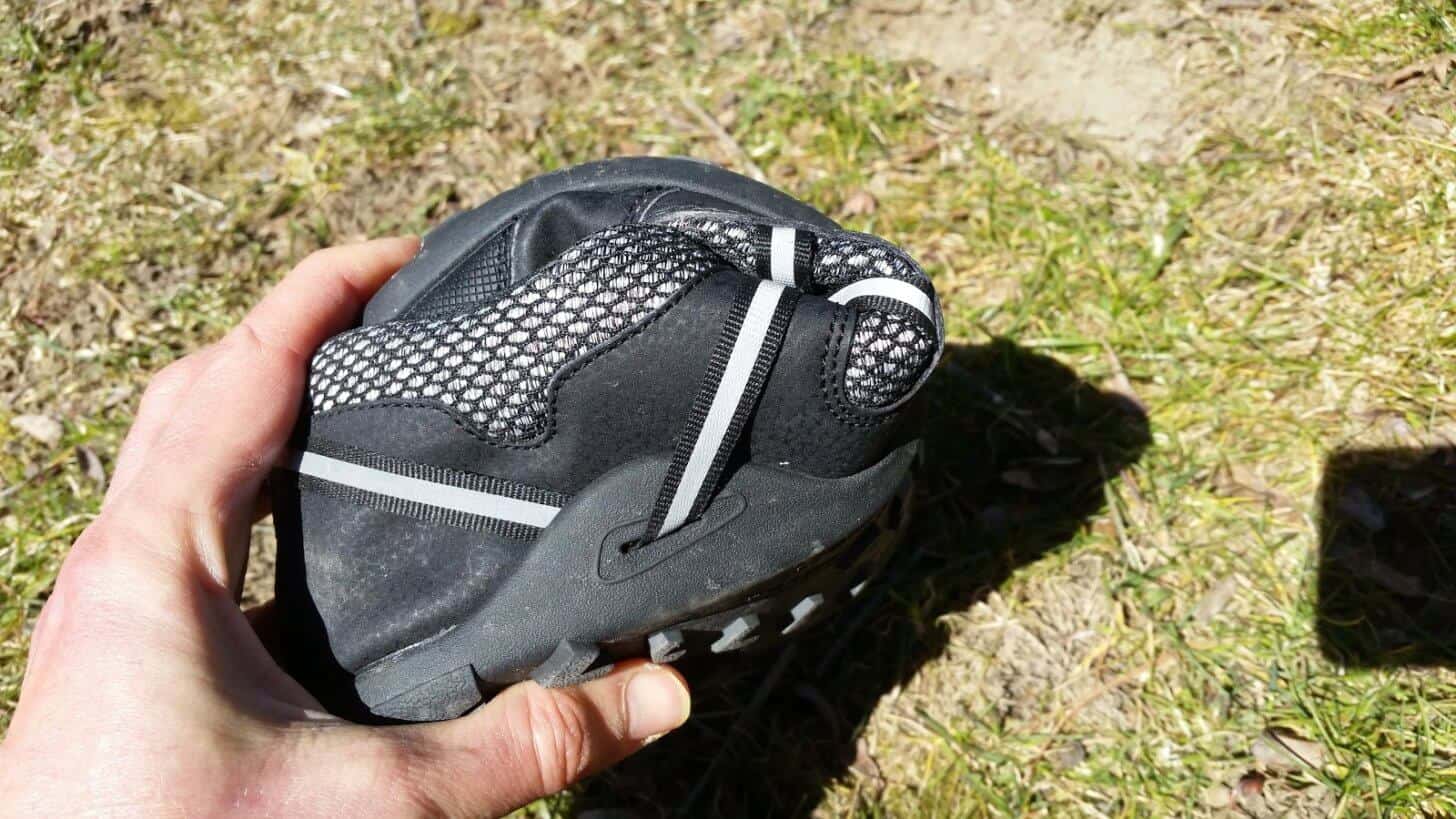
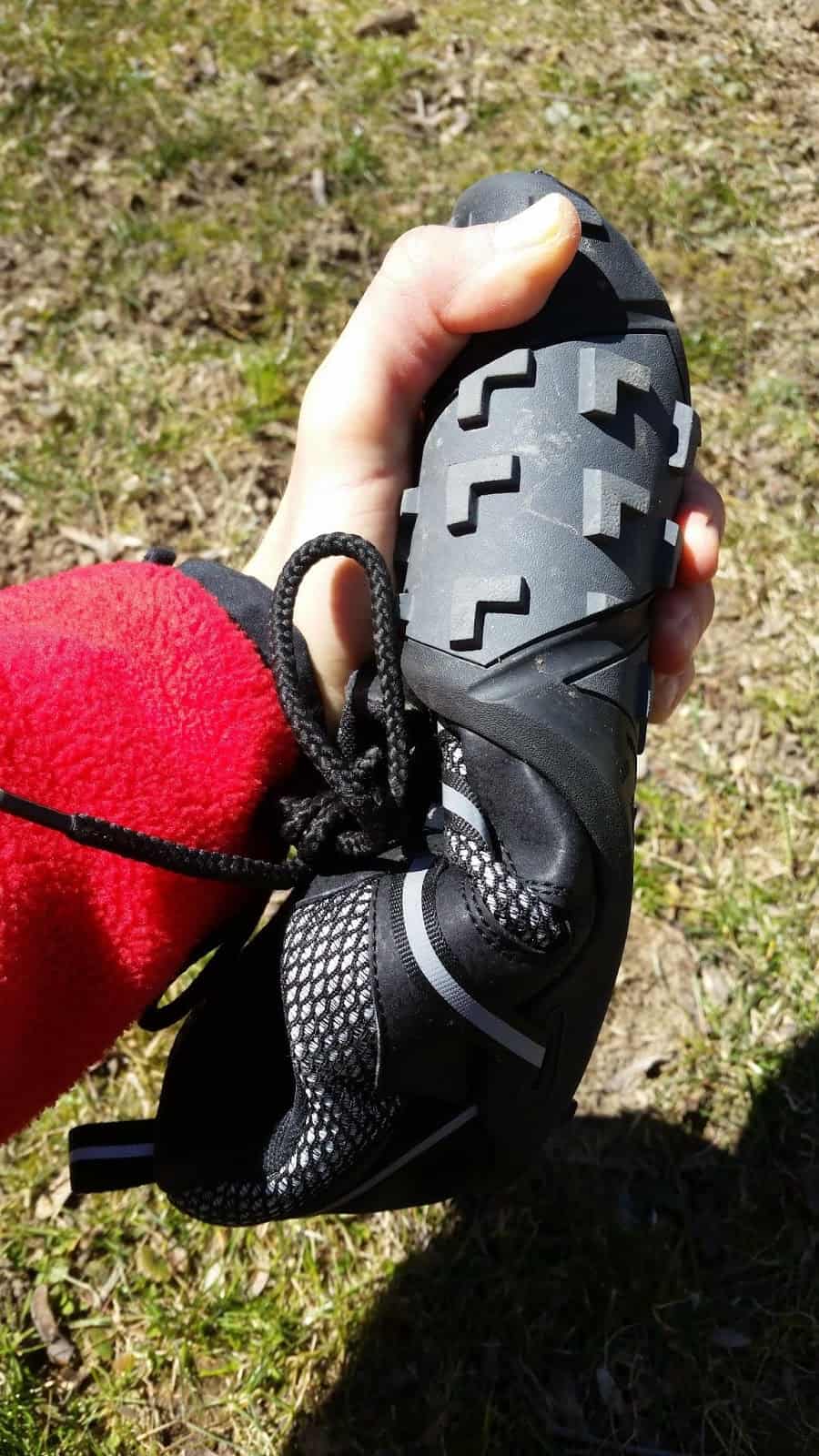
The company’s website advises that the Terraflex runs a little small, and indeed, I found size 12 on the tight side, even though for most other brands I normally wear 11.5. It may be that Xero Shoes run a little smaller than other brands, or that there is some variability in the manufacturing process. In any case, the company has a free exchange program, and the customer service department was very responsive when I needed to swap out sizes.
Traction
Traction is hard to measure objectively, but when your foot slips out on a slimy rock, that sure gets your attention!
Based on my testing, I’d describe the Terraflex’s traction as very good.
The treads consist of V-shaped lugs which are 4 mm in height. There’s a trade-off in lug height: the taller the lugs, the deeper you can bite into loose surfaces, like sand, dirt and mud – but tall lugs tend to reduce the total area in contact with a flat surface, like the face of the rock, where your ideal traction would come from the slick rubber tread of a rock-climbing shoe.
For conditions in upstate New York, the biggest traction concerns in my experience are scrambling over sandstone ledges and running through layers of dried leaves. While we have our share of muddy patches, we don’t typically see long stretches of soft dirt. For these conditions, the Terraflex lugs seem pretty optimal, and I think they’d perform really well in some of our local Hudson Valley races like the Escarpment Trail Run, Manitou’s Revenge, or the SRT Run/Hike.
Based on my experience running out west, I think they’d be great on sandy, gravelly, and rocky terrain, too. If I were going to go run Leadville again, or climb to the top of Mt. Whitney, I’d wear the Terraflex.
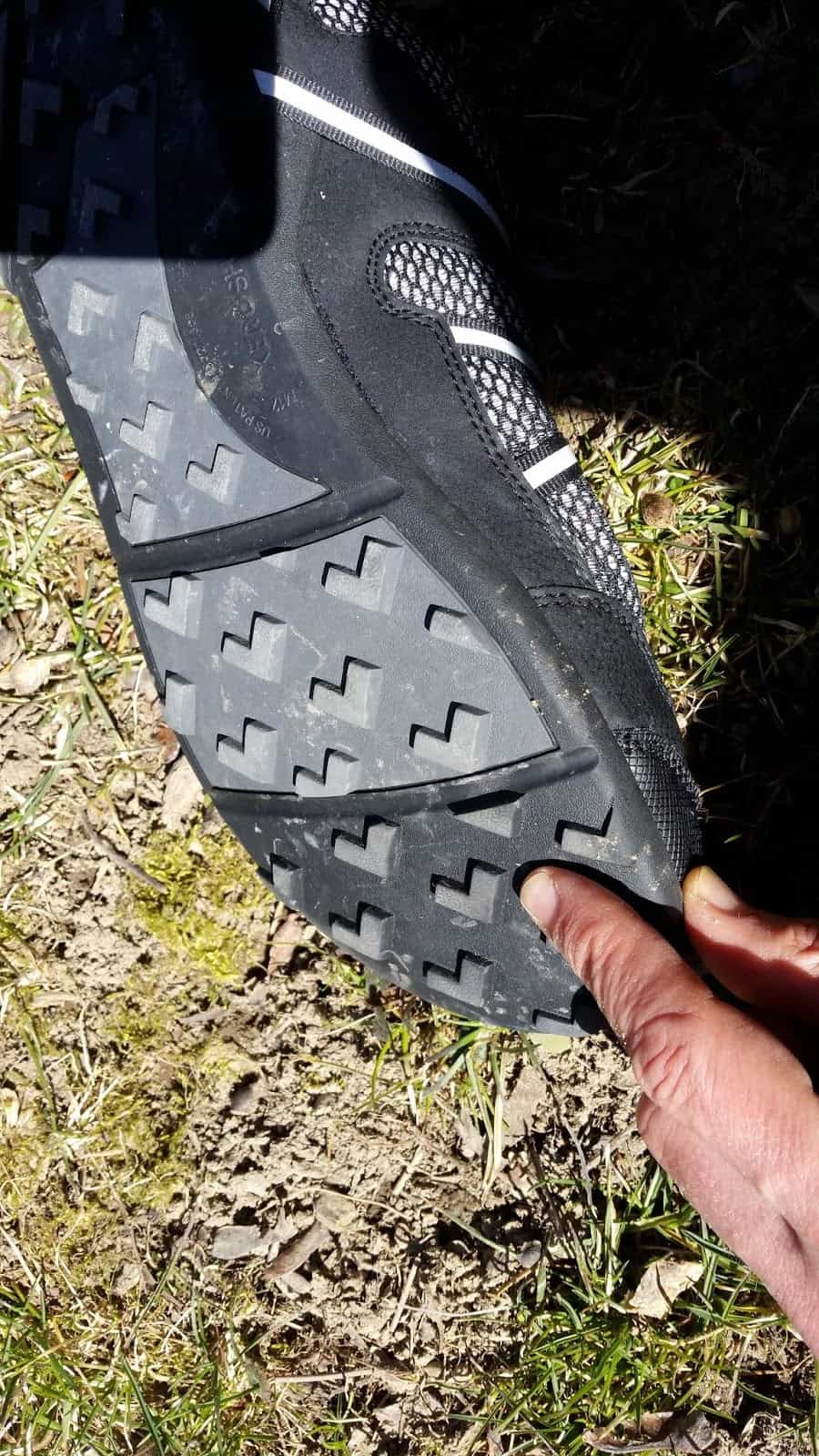
Product Strengths and Limitations
Based on my testing, I’d expect the Terraflex to be a strong contender in the field of minimalist trail-running shoes, thanks to the combination of comfortable natural fit, good traction, and protection against rocks and other rough surfaces.
One potential limitation I was not able to explore in my testing was the Terraflex’ performance in wet conditions. While I don’t mind wet feet for a day or two, over a protracted period wet conditions raise the risk of blisters, and shoes with soft uppers sometimes take a long time to dry. Should you wear Terraflex in rainforests, swamps, or monsoon conditions? I’m not sure.
I also don’t know how durable they’ll prove to be. However, the shoe comes with a 5,000-mile warranty on the sole, which is reassuring. (Xero Shoes didn’t hesitate to honor that warranty on a pair of Prio running shoes which I beat to pieces in the rocky Catskills.)
The biggest limitation to keep in mind is that for people who are not used to minimalist footwear, it’s wise to transition slowly. The zero drop feature and lack of any internal support are positives for minimalist runners and hikers used to moving naturally, but if you transition too quickly from conventional footwear, you could overwhelm muscles and tendons and risk injury.
Compared To….
- After a burst of popularity a few years ago, true minimalist running shoe sales have declined, and many of the major brands have backed away from the market. For example, INOV-8 no longer offers zero-drop shoes.
- According to an informal poll of barefoot and minimalist runners, another well-regarded zero-drop trail shoe would be the Merrell Trail Glove, which is slightly lighter at 7 ounces, offers 3 mm lugs, and is also designed to be worn sockless. Vivobarefoot’s Primus Trail is also cited as a favorite.
- Altra markets zero-drop trail running shoes, but because of the thicker soles, they are not regarded by everyone as truly minimalist. These might be an option for someone who wants more protection against rocky surfaces.
- Sandals represent another minimalist option. They’re great for summer running, and obviously not ideal for winter conditions (although some people have been known to wear them with toe-socks and microspikes). I’ve found they require very careful foot placement on steep and slanted surfaces, otherwise the straps can bite painfully into soft skin. That said, the winner in last year’s SRT Run/Hike’s 70-mile division (which follows a pretty rugged trail through the Shawangunk Mountains) wore sandals, so they’re worth considering for ultralight hiking as well as trail racing.
- Vibram Five Fingers offer a very natural experience, as the soles are light-weight and extremely flexible. I’ve used and enjoyed them on rocky trails and bushwhacking through the forest. For rougher surfaces, friends recommend the V-Trails.
Commentary
Now that spring has finally arrived in New York, I’m really looking forward to ditching the snowshoes, spikes, and heavy pack and getting back into ultralight mode, whether hiking or running. This may surprise some readers, but my first priority will be to drop shoes altogether and go barefoot, which for me is the most fun mode of experiencing the mountains.
Having said that, barefoot tends to be slow, especially on rocky trails, so on those hikes and runs where I have serious miles to cover (or when I want to keep up with fast-paced friends), the Terraflex is going to be my go-to shoe, as for me it’s exactly the right solution to the problem of sustaining a minimalist experience over long distances and rugged surfaces.
Provided that you’re used to a flexible zero drop shoe, I wouldn’t hesitate to recommend them for ultra-distance trail races and multi-day fastpack adventures.
Where to Buy the Xero Shoes Terraflex
- Xero Shoes Website (official manufacturer’s website)
Learn More About Minimalist and Lightweight Footwear (Related Content)
- Minimalist Footwear for Backpacking (Video), by Ryan Jordan
- Altra Lone Peak NeoShell Review, by Chase Jordan
- How to Keep Your Feet Warmer and Dryer When Backpacking in Wet Conditions with Lightweight Footwear, by Ryan Jordan
- Hiking-Worthy “Barefoot Shoes” (Forum Thread)
- Minimalist Shoes – Staff Picks
Disclosure
As part of this review and in the context of my affiliation as a Backpacking Light contributor, I received a complimentary pair of Terraflex shoes from Xero Shoes with no expectation or obligation to publish a review.
Some links in this review may be affiliate links, which means if you click on the link to this product and make a purchase at the retailer website, the retailer will contribute a portion of the sale to help support Backpacking Light. It doesn’t increase your cost, and it helps us maintain our site, fund content development, and grow member services! Thank you!

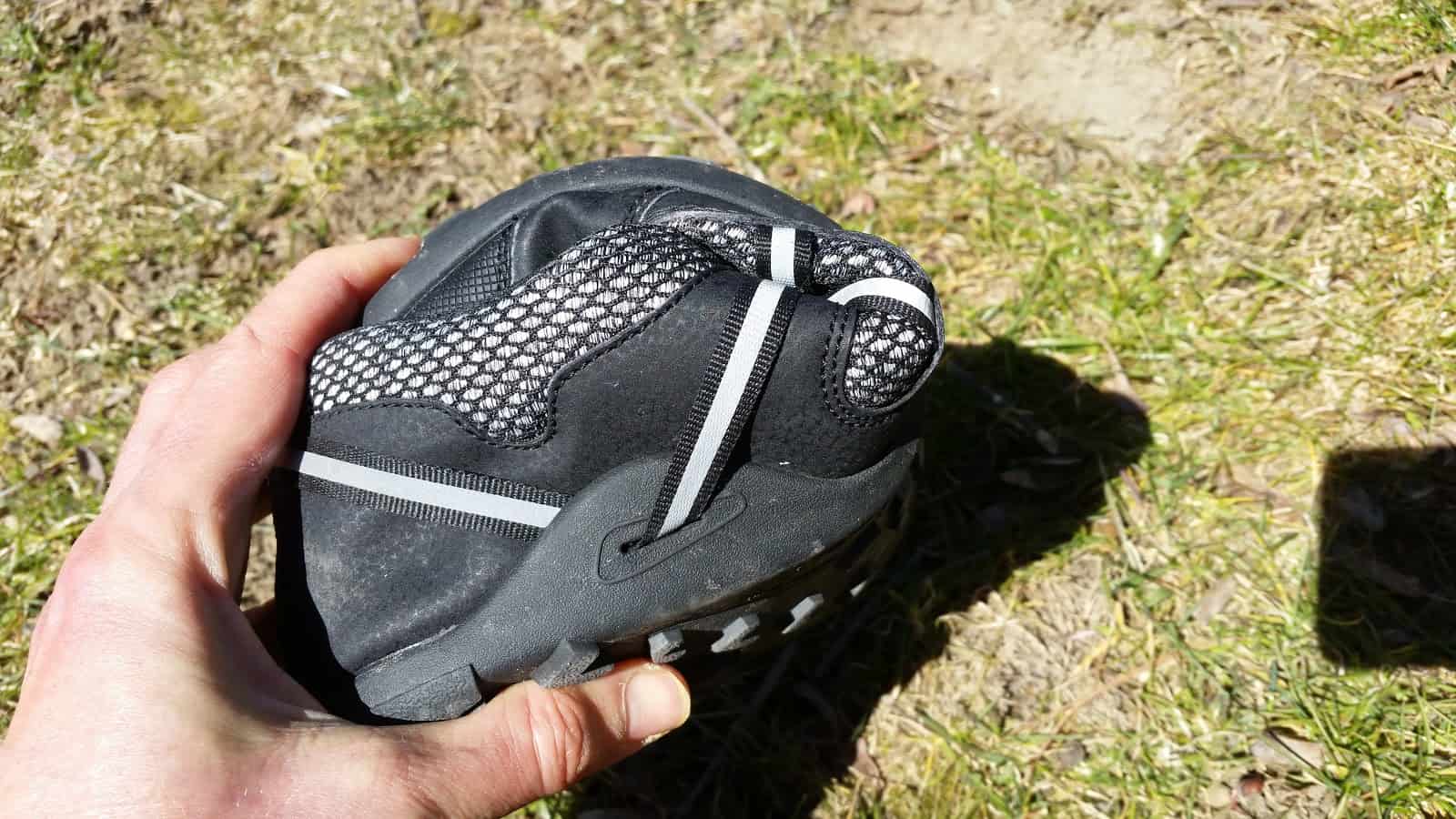


Home › Forums › Xero TerraFlex Review